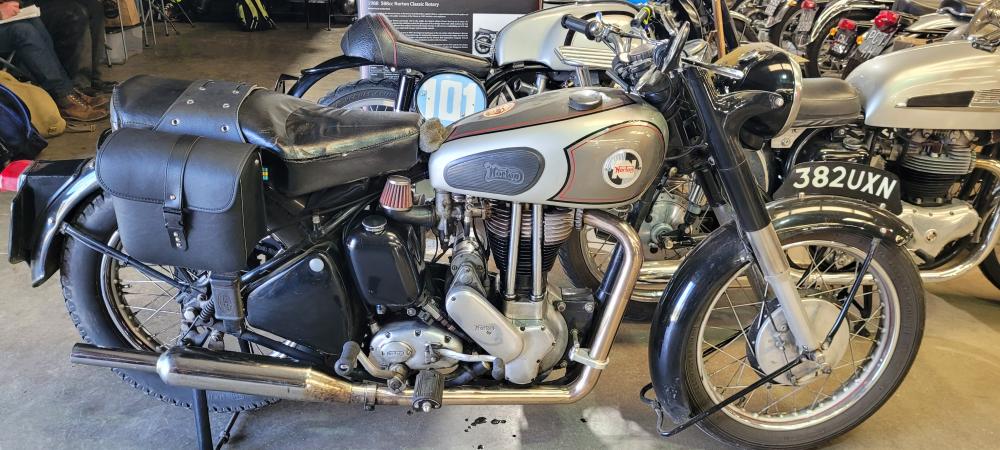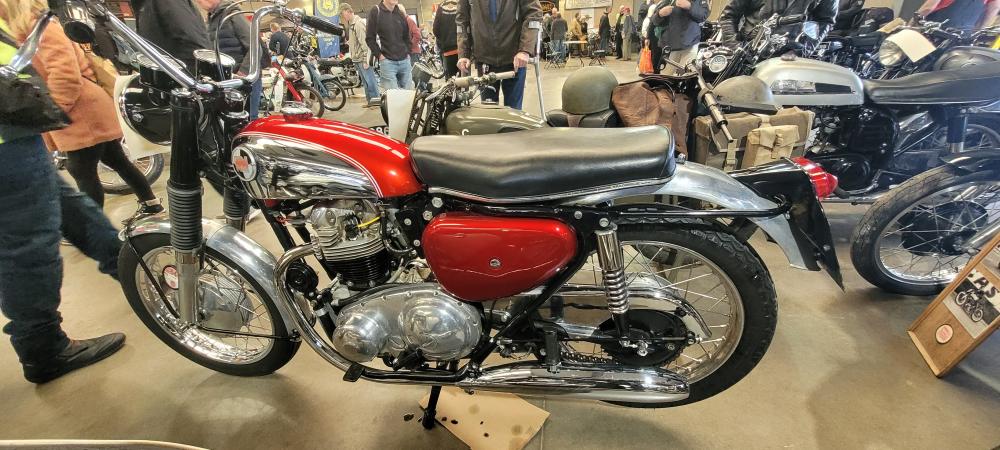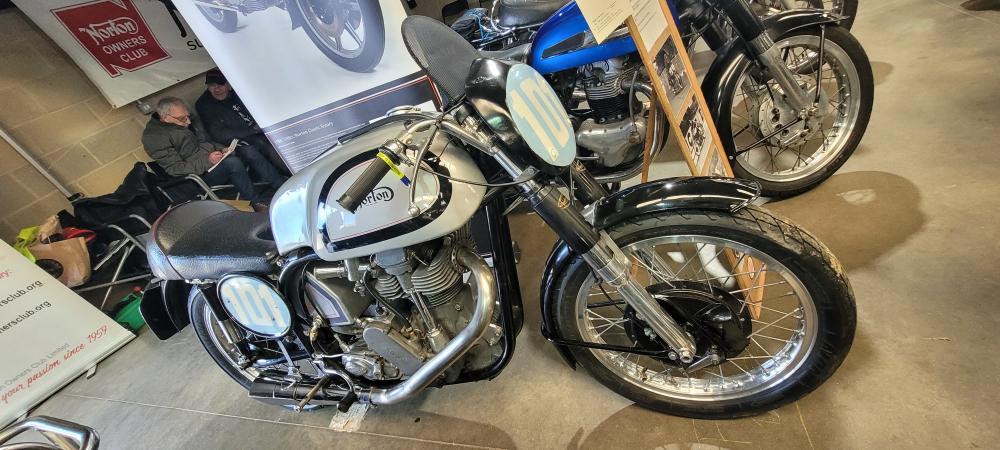A review of correspondence from NOC-L
Oil leaks, warping, alternator rotor to stator clearances and things going wrong in, or dripping out of the primary chaincase
Preventing primary chaincase leaks
In an effort to get the Commando in shape, I decided I had to fix the oil leak from the primary chaincase. It had got so bad that oil fumes, from the stuff burning on the exhaust pipe, were becoming a problem at traffic light stops. The actual strip was no problem, but I was haunted that night with the worry of forgetting to put all of the thrust washers behind the clutch drum on re-assembly.
The source of the leak was quite evident, oil was passing between the chaincase and crankcase, and dropping out the bottom. This was almost certainly caused by the full sump, (full of oil that is), which caused an incessant flow of oil during re-assembly the last time. This had prevented the gasket from sealing correctly, even with blue Hylomar. This time I did remember the thrust washers, then after I had bolted the inner chaincase to the crankcase, for some reason I put my hand behind the case, (where the long central bolt holds the case to the engine plates), and noticed that the washers that pack out the bolt to the back of the chaincase were quite loose.
If the gap between the central bolt and back of the chaincase were large enough, I assume this would cause the chaincase inner to 'fail' (crack, either at the crankcase join or the central fixing) in service. I estimated the gap to be about 10 thou. Before I put the clutch and engine sprocket back I fully tightened the chaincase to crankcase screws, then put the outer back on and tightened down the central nut. All of the play in the washers disappeared, and the chaincase appeared to be firmly connected to the engine.
The only other item of note was the problem I had in achieving an even gap between the alternator rotor and stator; this may be a little under 8 thou. in places, but there is a gap all way round.
Peter Aslan (paslan@uk.mdis.com) on NOC-L 20th. May 1997
Preventing leaks and setting up the alternator rotor/stator clearance (1)
Since Hylomar is actually soaked into gaskets, better results would have probably be achieved on the primary chaincase using a dry assembly. Heat would have burnt off the oil and the gasket would have sealed itself with time. If you have to use gasket goop, I'd recommend the clear silicon stuff.
The chaincase will distort very easily, as most Commando owners know. This causes failure of the large rubber 'O'-ring seal and it leaks like hell. It's best to junk the washers and make up a solid spacer of the same length, using either some pipe of the suitable i.d. and o.d., or a lathe. That way, there's no chance of you missing a washer out during a reassembly job. There oughtn't to be too much problem with 10 thou. of clearance, here - there's an awful long length of aluminium between the centre bolt and either end of the case, after all - but with a solid spacer it's easier to check if it really is 10 thou, and that there's not loads of grit between the washers, making it feel like 10 thou.
Regarding rotor/stator clearance, you really need 8 thou., since the rotor is alloy bodied, and hence prone to quite a large expansion coefficient, when heated up. It is located directly on the end of the crankshaft, after all. If all else fails try slotting the holes in the stator. They're not always drilled very accurately; either that, or the mounting studs are oft askew on Commandos.
8 thou. is what you need as an insurance against the rotor expanding and siezing in the stator, should anything untoward happen, such as running lean and causing an usually large heat build-up in the engine; as Commandos can do without giving any immediate symptoms away to the rider, such as misfiring, etc.
D.J. Walker (djw12@leicester.ac.uk) on NOC-L 21st. May 1997
Preventing leaks and setting up the alternator rotor/stator clearance (2)
Fitting The Chaincase
Basically, the shim washers have to be adjusted until there is no play when the chaincase is flat against the crankcase. Either too many or too few shims will cause the chaincase to lie askew of the crankcase and help cause an inadequate gap in the alternator. The way to check this out is to offer up the inner chaincase to the crankcase. If you can rock the case back and forth by pushing on the part near central stud and the part on the crankcase, you have too few washers. If it can touch on both the crankcase and the stud at the same time, but then you can then rock it up and down, you have too many washers. You will always be able to eliminate the play in the washers by torqueing down the big nut on the central stud, but that just bends the case and doesn't solve the underlying problem.
Alternator Clearance
You have to get an 8 thou. gap in there somehow, either by moving the stator around, bending the studs, or filing the inside of the stator in the tight places. When the bike gets hot and the parts expand, 'a gap all the way around' may not turn out to be enough and unbelievable disasters can occur if you get rubbing here. Incidentally, while the primary is off, it's a valuable modification to replace the crankcase screws with double-threaded studs - ¼" coarse on one side and ¼" fine on the other. The coarsely-threaded end goes into the case, and you then hold the primary on the fine-threaded end with nuts. To install the studs, drain the oil, clean out the holes with solvent, and screw the coarse threads of the studs in tight (by double-nutting) with red Loctite. Now you will have a much more solid mount for the primary, you can remove it in the future without draining the oil, and it's easier to line it up to get it back on. Note that one of the studs will have to be cut a bit shorter to clear the primary chain, but there's plenty of thread left over.
Mike Taglieri (miketync@aol.com) on NOC-L 22nd. May 1997
Setting up the alternator rotor/stator clearance
On the alternator problem, it really was just less than 8 thou. in one spot. However, I did take the alternator off and drilled out the holes a little, then with a lever against the thing, (it's difficult to get it in the right spot as the magnetic forces of the rotor act against you), managed to achieve the required 8 thou. all round. If you try this at home, please make sure you clamp the laminations of the alternator stator in a vice or something when drilling, otherwise the laminations will separate and you may end up with a damaged alternator. You also need to watch for the heat generated by drilling, and do it quickly and in small stages if required; again the heat will damage the alternator windings.
Peter Aslan (paslan@uk.mdis.com) on NOC-L 27th. May 1997
Sealants for primary chaincase leaks - a product recommendation
|
"Is there a 'standard' gasket sealer folks use for the primary case outer cover? I used to use the grey stuff but haven't liked the nasty cleanup required when removing the cover. I just tried the "soak the gasket in oil overnight" routine and it's leaking like a sieve." |
Gasket sealers will only do so much, if a chaincase is "leaking like a sieve", you have some fundamental problem like warped joint faces and maybe screw holes that need chamfering. As far as the mess, note that you only have to put sealer on the bottom side to help seal against drips. I use grey Yamabond, but have used a light smear of clear RTV in the past. With a good joint to work with in the first place, it doesn't take much to get an oiltight seal.
Wayne Bratt (bratt@cod.nosc.mil) on NOC-L 3rd. Jun 1997
Sealants for primary chaincase leaks - another product recommendation
I've used K&W Copper Coat (liquid in a can) for years, and find it seals most things very well. Unfortunately, you will find that it will stick your Mk.lll's chaincase gasket tenaciously, but I've regarded that as a small price to pay for oil tightness. I've often thought about sealing only the outer case to the gasket, but never actually tried it. I hate doing things twice almost as much as leaks. Of course, the 'black' gasket material isn't supposed to need any sealer at all, but I don't know of anyone's experiences with that technique either.
Greg Kricorissian (grkricor@ccs.carleton.ca) on NOC-L 3rd. Jun 1997
Sealants for primary chaincase leaks - yet another product recommendation
I use Loctite 518, anaerobic gasket compound. It has infinite working time, since it doesn't set up in the presence of air. Whatever squeezes out can be wiped off nicely with a cloth or toothbrush soaked in mineral spirits.
Stan Smith (sks3rd@aol.com) on NOC-L 3rd. Jun 1997
Oil migration into the primary chaincase
It's my understanding that the fluid in the primary case also functions to cool the alternator and the primary chain as well. I've been using ATF in my primary for the last 6 months and have about 7000 miles with it. It works well and has a significant detergent capability.
Related to this, I took my clutch apart yesterday after a long trip that left me with a grabby and sticky action. The plates were covered with transmission oil the consistency of paste and smelling of sulphur. The push rod was covered with it also and I had to use a pair of pliers to get it out. If there ever was any question that the push rod tunnel was a possible route of transmission oil contamination, forget it, it is.
To fix this dreaded problem I put a hose barb elbow on the inspection cover on the transmission, then I ran a hose to the air cleaner back plate with another fitting there. I put a hundred miles on it today and it seems to have cured it, but a longer test will tell. The slight vacuum in the air cleaner may be sufficient to stop the migration of the transmission oil. That little pin hole in the cover isn't enough to vent the trans case. When in use the air in it will expand as it heats up creating pressure in the case. I understand the Mk.llls have a more capable arrangment.
Bob Patton (bpatton@humboldt1.com) on NOC-L 20th. Jun 1997
Unable to adjust stator/rotor clearance
Thanks to the recent thread on alternator rotor/stator clearance and the inspiration it created, I pulled the primary chaincase back off my 1972 Norton project. Using a feeler gauge, I found clearance acceptable all around except in the 4 o'clock position. A large rubber mallet & a length of 2 x 4 produced no measurable change with any force I was willing to use. What should be done now?
Paul O'Neil (hudson29@aol.com) on NOC-L 7th. Jul 1997
Setting stator/rotor clearance (1)
This may not be the best way, but I remove the stator and clamp the metal plates with a tiny C-clamp, then drill the mounting holes oversize in a drill press. The plates tend to separate if you drill without the clamp. When installing, I use 4 feeler gauges spaced around the rotor to center the stator and then bolt it down.
Little (chlit@aol.com) on NOC-L 8th. Jul 1997
Setting stator/rotor clearance (2)
You have two options. One is to take the rotor to a machine shop and have a few thou. machined off. I've heard that a .005" to .010" cut is not unusual to get proper clearance. The second option is the route I took.
I shortened and shimmed the spacers behind the stator until I had proper clearance all around the rotor. By shortening the one closest to the tight spot and selective shimming of the others I solved my problem. You can experiment with some shim stock (beer can metal works well) to see if this will work for you before you shorten or modify anything. The problem is caused by warping of the inner primary case; it seems to happen to all the old ones eventually, so some form of clearance adjustment is required.
Ken Dubey (kdubey@pria.com) on NOC-L 8th. Jul 1997
Adjusting stator/rotor clearance - problem solved
As per the advice of several on the list, and Phil Radford at Fair Spares, I adjusted the mounting bolts holding the stator by slightly bending them in the direction of the tight spot. I did this by taking a ½" drive deepwell socket & and extension and sliding one of the stator spacers into the socket to protect the threads and center the stud in the socket. I bent all three just a hair, and trial fitted the components. The extra gap had disappeared, and miraculously, the 8 thou. feeler gauge can now be inserted anywhere.
Paul O'Neil (hudson29@aol.com) on NOC-L 14th. Jul 1997
You have two options .....
Setting stator/rotor clearance - another idea
Actually, there's a third option: you can file the inside of the stator where it's too tight. It's a hell of a lot cheaper than turning the rotor, and you're increasing the clearance only where you need it. The wire windings, etc., are not present in that area, so there's no danger of hurting them.
Mike Taglieri (miketync@aol.com) on NOC-L 19th. Jul 1997
Setting stator/rotor clearance - use a lathe?
|
I have been told that the rotor can be turned on a lathe to increase the gap ..... |
You are only talking about a couple thou. here and people have done this. It's not a great idea. The magnets get loose in time anyway and rotors have to be replaced. Also, turning can result in too much gap.
Setting the clearance is an easy fix. Remove the primary outer cover, loosen the stator retaining nuts enough that the stator can move, and use either pieces of shim stock, feeler gauges, beer can or other reasonably sturdy material of appropriate thickness around the circumference of the rotor to even up the spacing distance to the stator to the desired .008". Then tighten the nuts enough to hold the stator, remove the shims, finally tighten and recheck.
Exploding rotors
Lucas rotors, particularly on Norton motors with big torque pulses, loosen up the rotor magnets over time. They are on a hexagonal core, which acts like an impact driver, pushing them outwards once they have initially loosened a bit. Then you definitely run out of clearance, and they make a disturbing knocking sound (like the lower end going away).
They do occasionally explode; more often, they tangle up with the stator a bit at a time first, stop charging the battery, emit a foul odor (insulation cooking) and cost you $250 U.S. for replacement parts.
Tom Davenport (tom@thekinetics.com) on NOC-L 22nd. Jul 1997
Do not machine the alternator
I agree fully with Tom Davenport's comments on this topic. Do not machine the rotor or stator: they fitted together without binding at one time, and they should do so now. Machining the rotor will weaken it, and machining the stator will give rise to eddy currents (recall it is an AC machine), which will reduce its efficiency.
Why not pull the stator, remove the studs from the chaincase, and ensure that they are straight by rolling them on a flat surface? Check to see the rotor is on straight, and not cocked by swarf on its seating surface. Even better, ensure the crank stub that carries the rotor is not bent ... it wouldn't take much to cause the runout you're talking about.
The best way to check this is to remove the spark plugs, and kick it over whilst watching carefully for runout. If you have a dial gauge, use it... the runout should be nil on the crank stub. As a final thought, ensure that the stator surface (where the nuts seat) is flat and free from burrs, so that it will not shift when the nuts are tightened. Are the spacers under the stator all exactly the same length? I'm sure you'll find the cause without resorting to violence. Check everything logically and thoroughly.
Greg Kricorissian (gkricor@ccs.carleton.ca) on NOC-L 23rd. Jul 1997
Setting stator/rotor clearance - yet another idea
When I fitted a brand new alternator (rotor and stator) to my Commando I found that there was an interference at one point, i.e. nil or less than nil gap. I tried bending the studs in the same way as Eric Lamberts but it wasn't making enough (or any) difference. I have to say that I didn't want to apply too much torque as I felt that the inner primary case - which is what the studs screw into - would probably crack.
So, I took the studs out and gently filed them down so that the stator could move in the required direction. It's worth doing this by marking up all studs with an ink mark to indicate the side that needs to be filed, then removing and altering and refitting one stud at a time. Otherwise, if the wrong stud is fitted the filed surface may not suit the direction required. It all worked fine for me and the rotor spins up with a consistent gap all around when checked with the crank at very many positions of rotation.
Jeremy Nicholls (jeremy.nicholls@ntlworld.com) on NOC-L 11th. Jan 1998
Setting stator/rotor clearance - rotor turned down successfully
I had this problem when I fitted a 12V RM23(?) 180W kit to my Speed Twin. I ended up making new shims between the stator and the adaptor plate for mounting the new item on the old studs. Even after this, the rotor would not be totally evenly centred, but a few taps with a big rubber hammer on the studs cured the problem.
I've also turned the rotor down about 0.2 mm to achieve a bigger clearance (will give reduced performance). It was easily done with a lathe. I've had a rotor fail and break the primary due to insufficient clearance before, but now everything works just fine.
Espen Olsen (espen.olsen@matek.sintef.no) on NOC-L 12th. Jan 1998
Noisy primary due to insufficient oil supply to tensioner
I have had a Mk.lll for many years and worked on several others. After the bike sits for a week or so it makes a god-awful racket when the throttle is blipped. After riding for ten miles or so, the noise goes away. Other Mk.llls experience similar noises.
The cause is that the oil leaks out of the tensioner unit as the bike sits allowing the chain to go slack. Oil gets into the tensioner from a trough formed on its top by the sheet metal peice, into which oil drips from the top run of the chain. If the tensioner gets full of clutch crud, which it eventually will, oil can not get back into it, resulting in the noise you describe. The cure it to take is apart and thoroughly clean it, including the tiny holes in the piston and body. Mine is now taking longer than it should to quieten down which means either that the primary chain is getting tired or the tensioner needs cleaning as I haven't done that for maybe 10,000 miles.
Thomas Allen (thomasa@halcyon.com) on NOC-L 27th. May 1998
Procedure for cleaning up the chain tensioner
Tom is correct; here are the steps I took to eliminate this problem on my Mk.lll:-
- Dismantle the tensioner and clean it thoroughly
- Reseat the steel ball in the check valve
- Ensure the slot in the check valve body is oriented 'horizontally'
- Ensure the tensioner body is dead flat, front and back
- Ensure the steel tensioner cover plate is dead flat
- Seal the steel cover plate to the body with silicone
- Reinstall, fill with oil and bleed
Mine (fingers crossed) now does not lose its prime. Even when I took it out of storage in the Spring, the tensioner still worked fine right from a cold start.
Greg Krikorissian (gregg-k@spyder-it.com) on NOC-L 27th. May 1998








